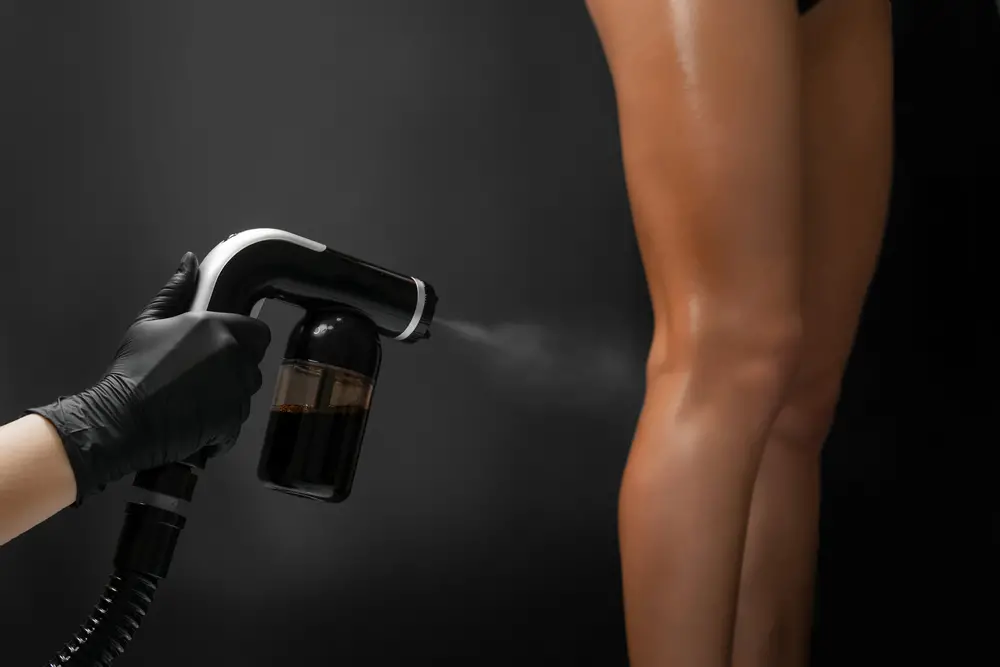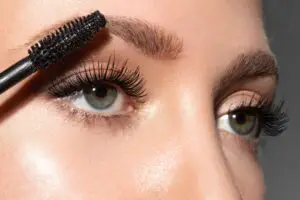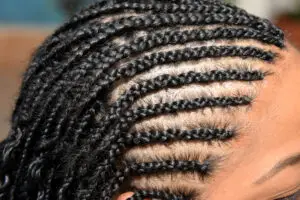Spray tans are a popular and convenient way to create a sun-kissed glow without exposing skin to harmful UV rays. While they’re designed to last for a week or two, sometimes the colour can become patchy, uneven, or just simply needs to be removed. There are several effective methods to get a spray tan off, leaving the skin clean and ready for the next application.
To remove a spray tan, one can use gentle exfoliation techniques, products specifically designed for tan removal, or home remedies to achieve the desired results. It is crucial to approach the process with caution and gently care for the skin to prevent irritation or damage whilst removing the unwanted tan.
Exfoliating gloves, specialised tan removers, and basic items like lemon juice and vinegar are just some of the tools at one’s disposal when attempting to remove spray tan from their skin. As spray tanning can be a regular part of a person’s beauty routine, knowing how to safely and effectively remove a previous application is essential to maintain smooth and healthy skin.
Understanding Spray Tan
Spray tanning is a popular alternative to sunbathing and tanning beds, providing a fake tan without the potential harm from ultraviolet (UV) rays. The main active ingredient in spray tan solutions is dihydroxyacetone (DHA), a colourless sugar that interacts with the amino acids in the outer layer of your skin, producing a temporary bronze colour.
DHA is approved for external use and generally deemed safe for self-tanning. It usually takes around 8-12 hours for the full colour to develop, and the tan typically lasts for 5-10 days, depending on how well you take care of your skin. When using a spray tan, you should follow a few spray tan tips to achieve the best results and extend the life of your tan:
- Exfoliate before your appointment to remove dead skin cells and create a smoother surface for the tan to adhere to.
- Avoid moisturisers, make-up, and deodorant on the day of your spray tan, as these products can create a barrier on your skin that may inhibit DHA absorption.
- Wear loose, dark clothing to your appointment to minimise the risk of rubbing or smudging the tan.
After your spray tan session, it’s crucial to practise proper spray tan care to prolong the tan and avoid unsightly fading or patchiness. Follow these guidelines to maintain your tan:
- Wait at least 8 hours before showering or engaging in activities that may cause excessive sweating.
- Moisturise daily to keep your skin hydrated and prevent premature exfoliation.
- Avoid harsh exfoliants or scrubs during the life of your tan, as they can strip the colour more quickly.
Although typically safe, it’s worth noting that some individuals may experience an allergic reaction to DHA or other ingredients in the spray tan solution. Before applying a self-tanner, it’s a good idea to conduct a patch test on a small area of skin to verify compatibility. Also, remember that a spray tan does not offer protection from the sun. Regardless of your tan, you should always protect your skin from harmful UV rays by wearing sunscreen or protective clothing when outdoors.
Exfoliation and Its Importance
Exfoliation plays a vital role in removing a spray tan effectively. This process not only eliminates dead skin cells but also accelerates the fading of the tan. In this section, we will discuss how to choose the right exfoliant, the process of exfoliation, and specific areas to focus on while exfoliating.
Choosing the Right Exfoliant
There are various types of exfoliants available in the market, including natural exfoliants and commercial exfoliating scrubs. While natural exfoliants like sugar or baking soda are more gentle on the skin, commercial scrubs may contain chemicals that can potentially irritate sensitive skin. When selecting an exfoliant, consider factors such as your skin type, the level of abrasiveness, and the ingredients in the product.
The Process of Exfoliation
Ideally, to exfoliate your skin, you should use exfoliating gloves or a mitt to facilitate the process. However, if these tools are not available, you can use your palms or a soft cloth. Begin by wetting your skin and applying a generous amount of your chosen exfoliant onto the exfoliating glove or mitt. Once ready, gently massage the exfoliant onto your skin in circular motions, focusing on the target areas. It is essential to maintain a gentle, consistent pressure to prevent damage to the skin. Rinse the area thoroughly with lukewarm water following the exfoliation.
Exfoliation Areas
While spray tan usually covers most of the body, specific areas may require additional attention during exfoliation. These areas include:
- Feet: Dead skin cells accumulate on the feet, especially the soles and around the toes, leading to dry skin. Pay close attention to these areas when exfoliating.
- Palms: The palms, like the soles of the feet, tend to develop rough skin and can be prone to dryness. Exfoliate the palms with care, focusing on the creases and around the nails.
- Knees: The skin on the knees is more prone to dryness, and the accumulation of dead skin cells can lead to uneven tan. Be sure to exfoliate the knees thoroughly to ensure a smoother, more even tan removal.
Remember to exercise caution when exfoliating these areas to avoid any discomfort or potential damage to the skin.
Natural Remedies to Remove Spray Tan
Lemon Juice
Lemon juice is known to be an effective natural remedy for removing spray tans. This is due to its citric acid content, which helps to break down the spray tan pigments on the skin. To use lemon juice, simply cut a lemon in half and rub it directly onto the affected area, or mix it with water and use a soft cloth to apply it. Be sure to rinse afterwards and moisturise the skin.
Baking Soda
Baking soda is another popular natural remedy for removing spray tan, as it serves as a gentle exfoliator. To use baking soda, mix it with water to form a paste, and then apply it to the skin using a loofah or a soft cloth. It’s important not to scrub too hard, as this could cause irritation. Let the mixture sit on the skin for a few minutes before rinsing it off with water. Don’t forget to moisturise afterwards.
Baby Oil
Using baby oil, such as Johnson’s Original Baby Oil, can also help remove spray tan by softening and breaking down the pigments. To utilise baby oil as a remedy, drench the skin with the oil and let it sit for five to ten minutes, but no longer than that, as it could lock in the old tan instead of removing it. Rinse the oil off and moisturise afterward.
Vinegar
Vinegar is another useful natural remedy for removing spray tan, due to its acidic nature. To use vinegar effectively, mix equal parts of water and white vinegar in a spray bottle. After a shower or bath, spray the mixture onto the affected areas, and let it soak for a few minutes. Rinse it off and follow up with moisturiser to keep the skin hydrated.
These natural remedies can offer a simple and cost-effective method for removing spray tans at home. However, it’s essential to exercise caution, test on a small patch of skin before application, and avoid excessive use of these remedies, as they may cause skin irritation or dryness.
Other Practices for Spray Tan Removal
Long Baths and Steam Rooms
Taking a hot bath or spending time in a steam room can help loosen up the spray tan on your skin, making it easier to remove. These practices open up the pores and soften the skin, allowing for a more effective removal of the product. Using a gentle exfoliating tool like a loofah can further enhance the tan removal process during your soak. Just be sure to do a gentle patch test before scrubbing your entire body to avoid irritation.
Swimming Pool
A dip in a chlorinated swimming pool can assist with spray tan removal. The chlorine in pool water helps break down the tan and remove it from the skin. Swimming in the pool will also promote natural exfoliation, further aiding the tan removal process. However, it’s worth considering that spending prolonged periods in a pool may cause dryness to your skin, so don’t forget to moisturise afterwards.
Scrubs and Washes
Using sugar scrubs or washes like OGX Coffee Scrub and Wash can be effective in removing streaks and patchiness from a spray tan. Make sure to avoid using harsh chemicals like acetone or nail polish remover, as they can damage the skin. Toothpaste, especially whitening toothpaste, can also help in removing small areas of the spray tan, but it’s essential to do a patch test first to avoid irritation.
Here are some good scrub options:
- Neutrogena Body Clear Body Scrub
- Tree Hut Shea Sugar Body Scrub Coconut Lime
- Soap and Glory Flake Away Body Polish
- Frank Body Original Coffee Scrub
Skincare after Tan Removal
After successfully removing the spray tan, it’s essential to focus on skincare. Regularly exfoliating and moisturising will prevent the skin from becoming dry and flaky. This can be achieved using appropriate and gentle skincare products, tailored to your skin type. Don’t forget to use sunscreen when heading to the beach or spending time outdoors, as your skin might be more vulnerable to sun damage after tan removal. Remember, healthy skin starts with a good skincare routine, and it’ll pay off in the long run.
Special Considerations for Spray Tan
Protecting Your Nails
When getting a spray tan, it’s essential to protect your nails from discolouring. Before the tanning session, apply a clear base coat or barrier cream to your nails. If some spray tan solution gets on your nails, gently remove it using nail polish remover, ensuring you don’t damage the nail surface. Maintain healthy nails throughout the tanning process by keeping them clean, moisturised, and polished.
Discolouration on Fabrics
Spray tan residue may cause discolouration on certain fabrics, especially delicate materials like silk. To prevent staining, wear dark, loose clothing during the tanning session. Avoid wearing anything tight or light-coloured that might rub against your skin, which may transfer the tan and cause
streaks and discolouration. If unintended staining occurs on your fabrics, try removing the stain using gentle detergent or consider using bleach if the fabric allows. Check the garment’s care label for specific instructions and precautions.
Taking Care of Residue and Streaks
Proper exfoliation and moisturisation are essential for avoiding residue and streaks after a spray tan. Before your tanning session, exfoliate your entire body using an exfoliating glove and gentle sugar exfoliator, to ensure an even surface for the tan. After the tan is applied, follow the recommended waiting time before rinsing off the excess solution. Once you start showering, use mild soap and water to gently cleanse your skin.
If you still notice residue or streaks after rinsing, try using a home remedy of baking soda and lemon. Mix lemon juice with baking soda to form a paste, then in the shower, scrub it on your skin using a loofah or shower sponge. This can help remove any remaining residue and even out your tan.
By considering these factors and following the appropriate steps, you’ll be able to enjoy a flawless spray tan with minimal risks or issues.
Conclusion
Removing a spray tan can be a straightforward process when done correctly. One effective method is to use a tan remover product specifically designed for eliminating lingering spray tans. These products often contain ingredients such as bicarbonate soda and aloe vera, which help to exfoliate and hydrate the skin.
Another option to consider is using exfoliating gloves in the shower. Gently rubbing the affected areas will help to lift away the spray tan by exfoliating dead skin cells. This can be further enhanced by using a suitable body scrub, such as Neutrogena Body Clear Body Scrub or Soap and Glory Flake Away Body Polish.
In addition, a homemade lemon juice and sugar scrub can be effective in removing spray tan, particularly from feet. The lemon juice’s natural acidity helps to fade the tan, while the sugar gently exfoliates the skin. Just mix fresh lemon juice with sugar, massage the mixture onto the affected areas, and rinse off with water.
Taking a dip in a chlorinated swimming pool is another helpful strategy, as the chlorine aids in removing the tan from the skin. When trying this method, ensure you rinse off thoroughly afterwards.
Being proactive with these techniques, and combining them when necessary, can lead to successful spray tan removal, ultimately leaving your skin looking fresh and evenly toned. Remember to be gentle with your skin and follow up with proper moisturisation to keep it healthy and nourished.

I’m Jennifer a beauty and wellness expert. I believe in promoting a sustainable and healthy lifestyle from within. Helping people feel good is my passion; whether it’s teaching yoga or offering skincare advice.







